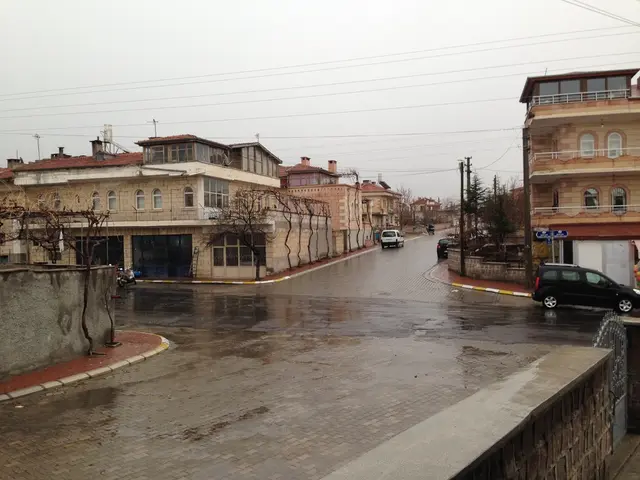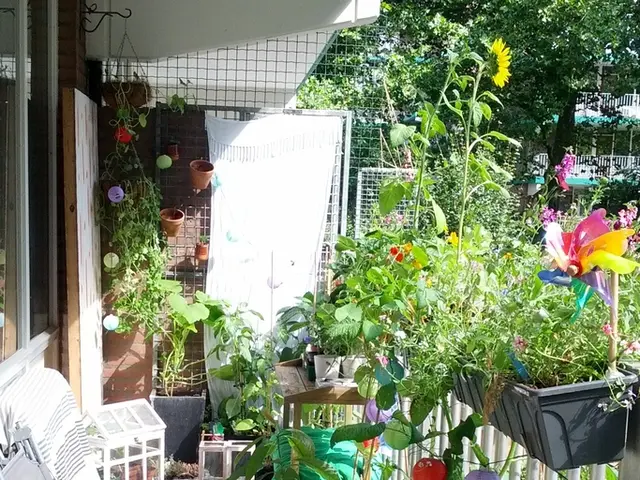DIY Bubble Solution Formula
Creating the Perfect Homemade Bubble Solution for Kid-Friendly Fun
Enhancing the quality of DIY bubble solutions can result in larger, more robust, and long-lasting bubbles, providing an engaging activity for kids of all ages. To create a superior bubble solution, experimenting with ingredients is essential. In this guide, we'll walk you through everything you need to know to create the optimum bubble solution for your kids to blow giant, captivating bubbles.
Understanding the Science Behind Bubbles
Bubbles are formed when a thin film of liquid traps an air pocket inside. Surface tension, the force that holds the liquid's molecules together, is what maintains the bubble's structure. To create larger and more durable bubbles, it's necessary to boost the surface tension of the bubble solution.
DIY Bubbles: A Fascinating and Educational Experience for Kids
Homemade bubble solutions are awe-inspiring and delightful for kids to observe, offering an excellent opportunity to introduce basic scientific concepts in a fun, interactive manner. Instead of buying bubble solution from the store this summer, why not opt for a homemade alternative?
Glycerin or Corn Syrup: Which Ingredient to Choose for Enhanced Bubble Durability
Adding either glycerin or corn syrup as an additional ingredient in your homemade bubble solution can help improve the bubble's quality. Both ingredients have advantages and disadvantages. Here's why you might opt for glycerin over corn syrup:
- Bubble Strength and Longevity: When trying to create strong, long-lasting bubbles, glycerin is more effective than corn syrup at increasing the bubble's strength and lifespan. Glycerin is a clear, odorless liquid with high viscosity, causing the bubble solution's film to thicken, making bubbles more resilient and agile against popping quickly. This is crucial for creating massive bubbles that can stand up to gentle handling and remain stable longer before fading away.
- Non-Sticky Solution: One advantage of glycerin is that it produces fewer sticky residues compared to corn syrup, making for a cleaner and more enjoyable bubble-blowing experience. When bubbles land on surfaces or skin, corn syrup can cause the bubble solution to become significantly stickier, which may not be appealing to some users.
- Superior Performance in Dry Conditions: Bubble solutions made with glycerin tend to perform better in arid weather or low humidity conditions. When the air is dry, bubbles made with glycerin are less prone to evaporating rapidly, allowing them to float gracefully in the air for an extended period. In contrast, corn syrup may not provide the same level of performance in dry conditions due to its stickiness and lower viscosity.
- Widespread Availability: Glycerin is readily available in most drugstores, supermarkets, or online, making it easily accessible for creating bubble solutions. It also mixes effortlessly with water and dish soap, resulting in a smooth blend with limited effort.
While glycerin presents several advantages, it's important to note that corn syrup remains a viable option for creating bubble solutions. Corn syrup is commonly found in grocery stores and can also enhance bubble strength, although to a slightly lesser extent than glycerin.
Furthermore, some individuals may prefer using corn syrup due to its food-grade status and non-toxic nature, especially when young children are involved in bubble play.
Ultimately, the choice between glycerin and corn syrup comes down to personal preference and the desired characteristics of the bubble solution, as both ingredients can optimize homemade bubble recipes and catalyze fun bubble-blowing experiences for kids.
Getting Started with Glycerin-Based Bubble Solutions
Glycerin helps create strong, long-lasting bubbles ideal for bubble play. To make your own bubble solution using glycerin, follow this simple recipe:
Basic Ingredients and Supplies Needed:
- 1 cup water
- 1/4 cup dishwashing liquid (free of added moisturizers)
- 2 tablespoons glycerin
- Measuring cups or spoons
- A mixing container
- Bubble wands or blowers
Instructions:
- Collect the ingredients and equipment.
- Pour the water into the mixing container.
- Add the dish soap to the water.
- Stir in the glycerin.
- Blend the ingredients together gently, taking care not to create too many bubbles or foam during the process.
- Allow the bubble solution to rest for at least an hour or, ideally, overnight. Allowing the mixture to settle enhances its performance.
- Test the bubble solution by blowing bubbles with your bubble wand or blower. Check the bubbles' durability and longevity.
- If the bubbles are not as strong as desired, adjust the proportions of the ingredients by adding more glycerin for greater strength or more dish soap for larger bubbles.
- Store any leftover bubble solution in an airtight container, label it, and keep it in a cool, dry area for future use.
- Before each use, give the container a gentle shake to remix the ingredients.
Crafting a Corn Syrup-Based Bubble Solution
Looking for an alternative to glycerin? Making a homemade bubble solution with corn syrup is an excellent option for creating durable, long-lasting bubbles. Corn syrup increases the bubble solution's viscosity, making the bubbles more rigid and less likely to burst easily. Here's a simple recipe for making a bubble solution using corn syrup:
Basic Ingredients and Supplies Needed:
- 1 cup water
- 1/4 cup dishwashing liquid (free of added moisturizers)
- 2 tablespoons corn syrup
- Measuring cups or spoons
- A mixing container
- Bubble wands or blowers
Instructions:
- Gather your ingredients and equipment.
- Pour the water into the mixing container.
- Add the dish soap to the water.
- Mix in the corn syrup.
- Combine the ingredients gently to minimize the formation of excess bubbles or foam.
- Let the bubble solution rest for at least an hour or, ideally, overnight. This gives the ingredients time to blend and improve the bubbles' performance.
- Test the bubble solution by blowing bubbles with your bubble wand or blower. Check the bubbles' durability and lifespan.
- If the bubbles do not match your expectations, adjust the proportions of the ingredients by adding more corn syrup for enhanced durability or more dish soap for larger bubbles.
- Store any leftover bubble solution in an airtight container, label it, and keep it in a cool, dry area for future use.
- Before each use, give the container a gentle shake to remix the ingredients.
Tips for Making the Best Homemade Bubble Solution
- If possible, opt for distilled water to avoid using tap water, which may contain impurities affecting bubble performance.
- Encourage creativity by using different bubble wands or unusual bubble blowers to create varying sizes and shapes.
- Promote gentle bubble blowing to extend the bubbles' lifecycle and prevent them from popping too quickly.
- Bubble solutions work best on humid days, as moisture in the air enables the bubbles to remain intact longer.
- Add food coloring to the bubble solution for vibrant, colorful bubbles.
- Refresh the bubble solution as needed, as solutions tend to perform optimally when they are fresh.
Enriching Your Homemade Bubble Solution Experience
Try experimenting with various DIY bubble wands and unique bubble blower designs to produce bubbles of various shapes and sizes. Encourage kids to use gentle blowing techniques when making bubbles, and inspire a sense of wonder as they explore the science behind bubbles. Making and blowing bubbles is an enjoyable, low-cost activity that fosters creativity, deepens scientific understanding, and brings families together.
Creating homemade bubble solutions not only leads to larger, more robust, and long-lasting bubbles for kid-friendly fun, but it also supplements STEM learning through hands-on activities. This educational approach engages young learners in the process of understanding the science behind bubbles.
Bubble-making can serve as a fertile ground for teaching basic concepts like surface tension, viscosity, and evaporation, while also piquing interest in more complex scientific topics like physics and chemistry. When kids experiment with homemade bubble solutions, they learn about the role of ingredients like glycerin and corn syrup in enhancing bubble strength and longevity.
The weather plays a role in the performance of homemade bubble solutions. On humid days, bubbles tend to hold up longer, as the moisture in the air helps maintain the bubble's structure. In contrast, on dry or windy days, bubbles may not last as long. However, incorporating glycerin or corn syrup can help counteract these effects, making it possible to create durable bubbles even in less-than-ideal weather conditions.
To create a superior bubble solution, replacing store-bought products with DIY alternatives can save money and provide a fun, interactive learning experience for kids. Bubble-making becomes an engaging, cost-effective science project, as well as a creative art activity that incorporates elements of earth and earth-friendly practices.
By opting for natural, eco-friendly ingredients like glycerin and corn syrup, families can reduce their environmental footprint and teach children about the importance of using sustainable resources. In this way, homemade bubble solutions can serve as a simple yet meaningful means of introducing the concepts of environmental science to young learners.
Furthermore, enhancing the quality of homemade bubble solutions provides fun, engaging activities for various age groups, from preschoolers in kindergarten to elementary school children and beyond. This activity can foster relationships among family members and friends, promoting bonding and facilitating conversations about science, exploration, and creativity.
Bubble-making can also play a role in supporting workplace wellness and mental health. Engaging in fun, stress-relieving activities like blowing bubbles can help reduce anxiety and promote a sense of calm. In addition, producing fascinating, visually appealing bubbles can boost mood and encourage meditation-like mindfulness, allowing adults to step away from work-related stressors and improve focus.
Homemade bubble solutions can have practical applications in various industries, including healthcare and medical research. For example, therapies and treatments for chronic diseases, such as cancer and respiratory conditions, may benefit from the use of bubbles to deliver medication or promote lung function. Digestive health, eye health, hearing, and skin care could also potentially be improved through the use of bubble-based procedures or devices, as well as through advanced research in environmental science, men's health, and women's health.
As we continue to grapple with complex issues like climate change, mental health, and chronic diseases, the creation of engaging, educational activities like homemade bubble solutions can serve as valuable supplements to traditional learning methods. By fostering curiosity, encouraging exploration, and promoting critical thinking, activities like bubble-making can help prepare kids for success in a rapidly changing world.
In conclusion, creating homemade bubble solutions offers numerous benefits for kids, families, and the broader community. Whether used for educational purposes, stress relief, or even practical applications in various industries, engaging in bubble-making activities can foster a love of learning, deepen scientific understanding, and strengthen relationships. So, let's get blowing and create memories while mastering the art of bubble science!






